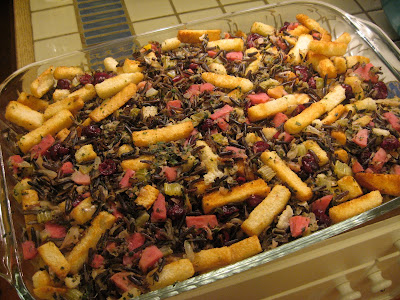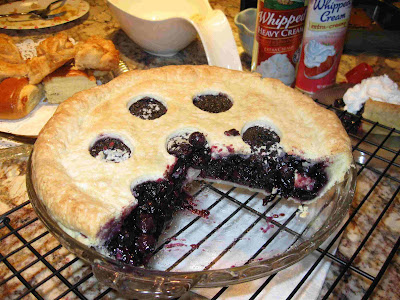We had a small, quiet Thanksgiving dinner, with just our family and J&J's. It was my turn to host, so I was in charge of turkey, stuffing, gravy, potatoes and one dessert, with J bringing sides, rolls and another dessert. I love stuffing, so I made two whole batches, not realizing that J&J's kids wouldn't eat any (!). I was thinking about the copious amount usually consumed by my brother Rib. I love having at least part of the stuffing cooked inside the bird, so I wanted a recipe for a stuffed turkey that would still turn out moist and delicious, and decided to try the latest turkey guidance from Cook's Illustrated.

Table setup with kissing corn (kids' table visible through doorway at center-right).

Table setup with pressed-glass turkey candle holders and linens and silver from my grandmother.
Wild Rice, Apple and Dried-Cranberry Stuffing from Gourmet (made by me)

This stuffing was very good--it's pretty much just a basic bread stuffing with sautéed celery and onion and fresh parsley, sage & thyme, then some cooked wild rice, diced apple and dried cranberries stirred in. I would recommend either cooking this in the bird or keeping it covered the whole time it is in the oven--the wild rice on the edges got a bit crunchy/chewy.
Rolls rising (made by J from my great-grandmother's recipe).
 Swiss Chard and Sweet Potato Gratin
Swiss Chard and Sweet Potato Gratin from Smitten Kitchen (made by J). This was delicious but very rich. Half a recipe would have been plenty for our small two-family group (again, the kids didn't eat much of it).

Old-Fashioned Stuffed Turkey from Cook's Illustrated's November-December 2009 issue.

This recipe calls for a 12-15 lb turkey, and mine was near the upper limit of that range (I did want
some leftovers). A sidebar in the magazine lists the "secrets" to a great old-fashioned stuffed turkey:
1. Dry brine (rubbing turkey with salt under the skin and in the cavity 24-48 hours ahead of cooking)
2. Stab the fat deposits with a skewer to aid the rendering of fat
3. Dry rub with baking powder and salt just before roasting to encourage browning (I did not do this step, as in an earlier recipe trial of a roast chicken recommending this technique, it imparted a slight chemical taste)
4. Bard the turkey by draping strips of salt pork on its back while roasting
5. Combine stuffing cooked inside and outside the turkey (doesn't everyone do this anyway?)
6. High-heat finish for the last 45 minutes to crisp the skin.
Now, there were a couple of other small ways (in addition to number 3 above) in which I deviated from the recipe. Nevertheless, the turkey was moist and flavorful, giving off lots of fat and basically no juices during its roasting time (I poured off the grease and scraped up the brown bits to dissolve as much as I could into the gravy, straining to get out the undissolved bits; my brother pronounced it the "best gravy ever"). Here's how I did it:
Old-Fashioned Stuffed Turkey
adapted from Cook's Illustrated Nov-Dec 2009
Serves 10-12
1 12-15 lb turkey
3 T kosher salt
12 oz salt pork, cut into 1/4"-thick slices and rinsed
onion, celery, carrot and a few sprigs fresh thyme for gravy neck stock, chopped roughly
Your favorite stuffing recipe (besides the wild rice one linked above, I made a traditional stuffing with sautéed onions and celery and fresh parsley, sage and thyme. I did not make homemade bread for the stuffing this year, and missed it.)
Now, two days before Thanksgiving, having already put the turkey in the fridge to thaw several days before, you go to pull out the giblet/neck packet and salt the turkey according to the recipe. After having removed it from its wrapping, you discover that the bird is still frozen solid in the middle and completely unwilling to birth its packet. You panic and put the turkey on a rack over a broiler-pan bottom in the fridge, hoping that the direct contact with the fridge air will thaw it sufficiently by the next day.
One day before Thanksgiving, the giblet/neck packet is just barely able to be pried out of the cavity. You heat a little oil in a saucepan and brown the snot out of the neck, then sauté the chopped vegetables in the same pan, scraping up browned bits. Add the neck back in, add water to cover, and simmer for a few hours. Return to still very, very cold turkey, and rub 3 T kosher salt in cavity and under skin of breasts and legs, trying mightily not to tear it where it's become slightly dried-out and fragile from its uncovered overnight fridge stay. Cover it with plastic wrap, put it back in the fridge, and hope for the best.
Thanksgiving morning, get the turkey out of the fridge, remove plastic wrap, and hope it comes to something resembling room temperature by roasting time. Use a skewer to poke lots of little holes (1" apart) in all the thick, fatty parts of the skin on the breasts, thighs, legs and back. Prepare stuffing, then line cavities with cheesecloth and put in as much stuffing as will reasonably fit, leaving the rest in a bowl in the refrigerator. Preheat oven to 325 degrees. Place turkey breast-side down on a rack in a roasting pan and drape back with slices of salt pork.
Roast breast-side down until thickest part of breast measures 130 degrees, 2-2.5 hours. Remove from oven, close door, and increase temperature to 450 degrees. Transfer turkey in rack to another pan, remove and discard salt pork, remove stuffing bag, and turn turkey breast-side up. Empty stuffing back into reserved stuffing in bowl and mix together, then put in large casserole dish. Pour drippings from pan into strainer over fat separator, scraping pan with a silicone spatula.
When oven is up to temperature, return turkey in rack to roasting pan and roast until skin is brown and crisp, thickest part of breast is 160 degrees, and thickest part of thigh is 175 degrees, about 45 minutes. Transfer turkey to carving board and let rest 30 minutes.
Reduce oven temperature to 400 and bake stuffing until it reaches 165 degrees in the center. Make gravy from defatted drippings, neck stock, and a well-mixed slurry of flour and water, plus some of the potato cooking water if desired, seasoning to taste (probably won't need much salt!).
This was a fabulous turkey, in spite of the stressful moments that occurred in its preparation. That overnight uncovered fridge stay that dried out the skin some made it roast up perfectly, cracklingly crisp--my brother said it was like pork rinds only better--but left the flesh moist and delicious. This is a great, easy, non-chemical-y way to get the skin really, really crisp. It did make it quite a bit harder to rub the salt under the skin, but if I'd been able to do the salting before the drying of the skin, maybe that would solve that problem? Next time will tell.
For dessert, J brought a perfectly-delicous Costco pumpkin pie and her homemade pecan dacquoise pie. and I made
Banana Chocolate Bread Pudding, using leftover challah from previously having made
Pumpkin Pie Bread Pudding with Bourbon Toffee Sauce for a friend. The challah wasn't left over, per se, because I did use a whole loaf for the first bread pudding, but it was left over because, after searching high and low for already-baked challah, I made my own. I guess in the middle of Thanksgiving week, all the bakeries are turned over to dinner rolls, and there wasn't any challah. I suppose I could have substituted, but I wanted to follow the recipe as closely as I could, so there I was, two nights before Thanksgiving, madly making challah late in the evening and about killing my KitchenAid in the process. Anyway, both of them turned out delicious, though I should definitely have used less than the whole loaf for the banana pudding.
And after all that effort over the bread, I couldn't muster up a couple tablespoons of bourbon for the toffee sauce, so I used Kahlua instead. Next time for the bourbon.
